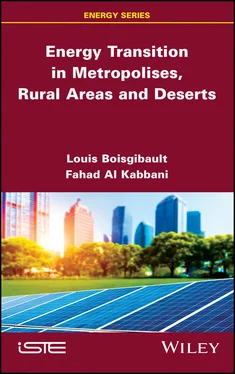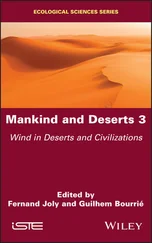– S: dry season in summer for the French Riviera and Senegal;
– F: wet and rainfall every month of the year for Lille.
Other rainfall classifications, such as monsoon climates and heavy rainfall, are not applicable to the selected sites.
The third letter finally specifies the amplitude of the annual temperature cycle with:
– a: hot summer for the Côte d’Azur: average temperature of the hottest month >22°C;
– b: temperate summer for Lille: average temperature of the hottest month <22°C and average temperatures of the four hottest months >10°C;
– h: dry and hot for Senegal, Morocco and Saudi Arabia: average annual temperature >18°C.
Other temperature variation classifications, such as very cold winters, are not applicable to the selected sites.
This exercise shows that, for the land selected:
– not all terrestrial climates are covered, including tropical (A), continental (D) and polar (E) climates;
– the desert climate of Ouarzazate is similar to that of Saudi Arabia (BWh);
– the level of low rainfall in the Pays de Fayence is similar to that of Bokhol in Senegal (S).
Table 1.3. Climate in the selected areas according to the Köppen classification
| European metropolis of Lille (France) |
CFb |
| Pays de Fayence (France) |
Csa |
| Ouarzazate (Sahara Desert, Morocco) |
BWh |
| Neom (Saudi Arabian Desert) |
BWh |
| Riyadh (Saudi Arabia) |
BWh |
| Bokhol (Senegal) |
BSh |
Riyadh and the Sahara Desert, which are at the level of the Tropic that crosses 18 countries, do not have a tropical climate for all, because of the important continental mass.
The energy sector is heavily impacted by the climate, which conditions living habits for housing, transport and industrial practices. Mastering climate data makes it possible to better estimate the energy production required to enable consumption. Good prediction of meteorological variability has a direct influence on the supply–demand balance of electricity, on the planning of plant maintenance operations and on the risks associated with extreme weather events.
Similarly, the energy sector is a major emitter of greenhouse gases, due to the very significant industrial installations in all components of the sector’s value chains. Carbon dioxide (CO 2) is the main gas, along with water vapour (H 2O), which is emitted. Its concentration in the atmosphere is measured by the World Meteorological Organization (WMO) in particulate matter per million (PPM) and exceeded 415 PPM at the end of March 2019, an increase of 48% compared to 1,750 (280 PPM). This concentration inexorably increases each year through new emissions and is insufficiently reduced by the absorption of CO 2by the oceans and forests. The development of urbanization tends to destroy these carbon sinks, which are important to preserve. In addition to CO 2, we must not forget the emissions of methane (CH 4), nitrous oxide (N 2O) and about 40 other gases identified by the IPCC, less concentrated in the atmosphere but sometimes more harmful.
In its “New Policies” 2 scenario, the International Energy Agency estimates that energy-related CO 2emissions will continue to increase until 2040. This trajectory is problematic in terms of meeting the commitments made at COP21 for the Paris Climate Agreement. It is incompatible with scientific recommendations to combat climate change and with the commitment to stabilize global warming due to human activities below 2°C by 2100 (compared to pre-industrial temperature) by strengthening efforts to reach the 1.5°C target.
1.4. Energy sectors analyzed by field
The six selected sites have their own geographical characteristics and have always used adapted energies. They are engaged in a process of energy transition, each at its own scale, at its own speed, in its own way and with its own constraints to manage.
Box 1.2. Energy sectors studied by field
Metropolises: Riyadh (Saudi Arabia) and the European Metropolis of Lille (France)
– Stock energy: Oil, gas, coal (hydrocarbons) and nuclear.
– Energy efficiency.
– Flow energies: Biofuels, biomass, biomethane (household waste incineration), ocean energy, small wind, medium and high geothermal energy, building integrated photovoltaic solar energy and solar thermal energy.
– Alternative fuels: NGV, electricity, hydrogen.
– Networks: Transport and distribution of oil, electricity, gas, heat and cooling.
Rurality: Pays de Fayence (France) and Bokhol (Senegal)
– Stock energy: Oil, gas, coal (hydrocarbons) and nuclear.
– Energy efficiency.
– Flow energies: Biofuel, biomass, biomethane, ocean energy, wind, low-energy geothermal energy (heat pumps), hydropower, solar photovoltaic and solar thermal.
– Alternative fuels: NGV.
– Networks: Electricity transmission and distribution.
Desert: Ouarzazate in the Sahara (Morocco) and Saudi Arabian desert
– Stock energy: Drilling of hydrocarbons and minerals.
– Flow energies: Biomass, wind, solar photovoltaic and solar thermodynamic with concentration (parabolic trough mirrors, solar tower).
– Networks: Transport of hydrocarbons and electricity.
Not all energy sectors are studied in detail. The aim is to see which ones are best suited to a given territory, to understand why sectors are not being exploited more, to study examples of achievements, to analyze the challenges in terms of energy transition for buildings, transport and industry and to find solutions according to three types of space.
1 1 Map made by the author.
2 2International Energy Agency (2018). World Energy Outlook.
Конец ознакомительного фрагмента.
Текст предоставлен ООО «ЛитРес».
Прочитайте эту книгу целиком, на ЛитРес.
Безопасно оплатить книгу можно банковской картой Visa, MasterCard, Maestro, со счета мобильного телефона, с платежного терминала, в салоне МТС или Связной, через PayPal, WebMoney, Яндекс.Деньги, QIWI Кошелек, бонусными картами или другим удобным Вам способом.












